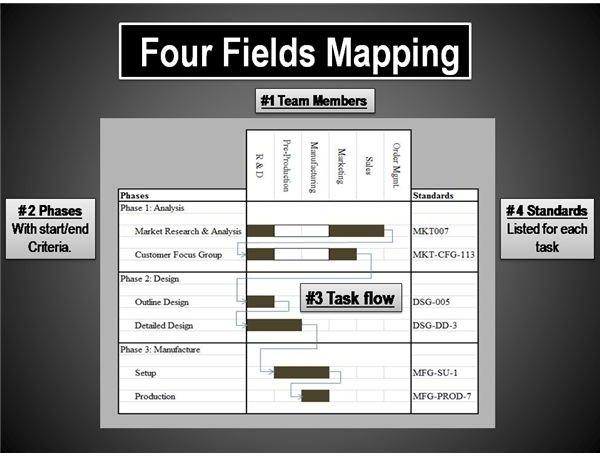Four Fields Mapping: A Japanese Approach to Project Planning
An Alternative Approach to Project Planning
Four Fields Mapping is an alternate approach to project planning given by the Japanese. It retains some of the useful aspects of conventional project planning but puts a very high emphasis on quality and teamwork.
This emphasis on quality and teamwork is obtained through:
- Making use of standards in the project plan itself against individual tasks / project phases as against a separate quality plan / policy for the project
- Identifying and assigning team members for each task within the project at the time of project planning (resource planning is not performed as a separate activity)
The Four Fields
The Four Fields used in Four Fields Mapping are
- Team members - These are the various members of the project team to whom individual tasks are assigned.
- Phases - These are various phases of activity which will give overall structure and direction to the project.
- Tasks - These are the individual activities that need to be completed in order to finish the project successfully.
- Standards - These are the various parameters on the basis of which task completion should be evaluated.
Constructing a “Four Fields Mapping”
The following steps are normally followed in order to construct a four fields mapping:
- A suitable cross-functional team is identified that is used for subsequent planning.
- The project is broken down into phases as appropriate. Each phase has a unique leader and the project’s leadership will change over its lifetime. The most appropriate person leads the project as per the project’s phase, and focus is on teamwork and the project, and not upon a project manager.
- Phases are broken down into tasks and are plotted upon the chart in order to indicate the teams working upon them.
- Important tasks or milestones are evaluated against suitable standards during review meetings.
Differences From Conventional Project Planning
Conventional project planning would involve the following activities
- Using a work breakdown structure (WBS) to breakdown the work
- Making use of the critical path method (CPM) and PERT charts to identify dependency between activities
- Using a Gantt chart to map the activities on a timeline
- Allocate tasks to various individuals / teams
- Monitor and control the progress of the project and adjust for holidays / delay etc.
This approach has many advantages and is widely used. But the focus of this approach is primarily on the work itself and not on who performs the work. Quality is not taken into consideration here, and is considered as a separate quality policy/plan if at all.
These are the primary two differences between four fields mapping and conventional project planning, which takes a very team-member-focused “people-centric” and standards-based “quality-centric” approach toward project planning.
